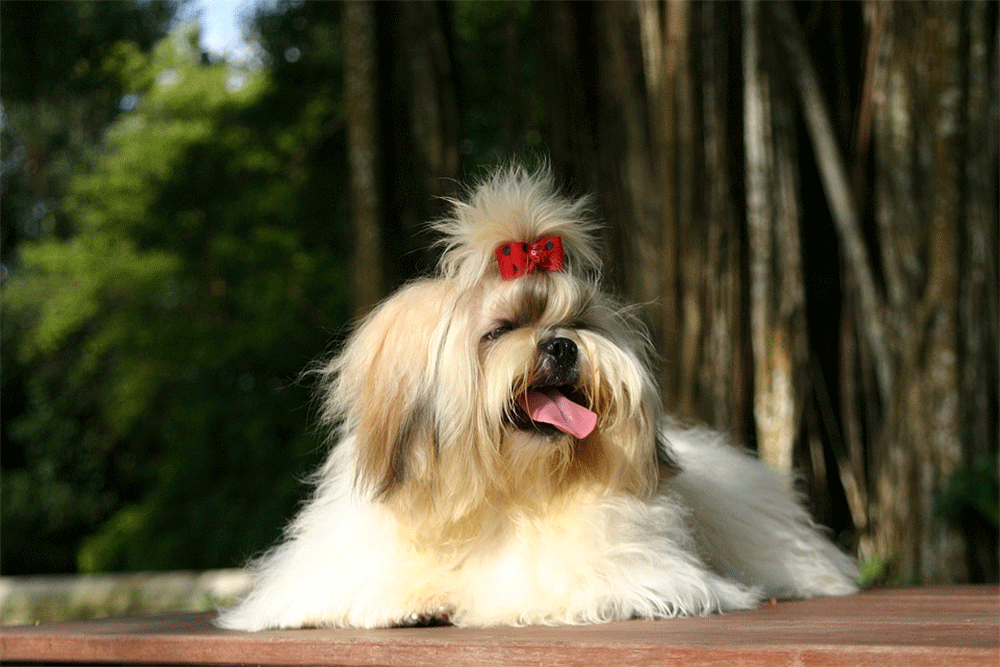If you’re interested in becoming a Shih Tzu parent, then it is important that you are aware of their health requirements before you commit to adopting one.

New Shih Tzu owners or individuals who are simply interested in learning more about this breed might be wondering: what skin problems, issues, allergies, and bumps do Shih Tzus have, and how do you treat them?
In this article, I cover some of the health issues that Shih Tzus are susceptible to and how to treat them when they occur so that you’re more prepared as a dog owner. That being said, this should only be taken as a rough guide and is not intended to replace the advice of your veterinarian.
So without further ado, let’s get started.
As a breed, the Shih Tzu’s long coat can be a trap for a wide variety of allergens, and they are prone to a variety of health problems, causing discomfort if not treated, with their skin being just one regular issue that you should be aware of.
If your Shih Tzu is experiencing any kind of allergies, you might begin to notice itching, biting, and scratching at the source of their discomfort. Additionally, hot spots, flaky skin, rashes, and hair loss are all common skin reactions. Bearing this in mind, then, it’s not out of the ordinary for Shih Tzu to develop an array of skin allergies, rashes, and bumps over their lifetime.
So, what kind of conditions should you be aware of? Below are a number of skin problems, issues, allergies, and bumps that you should know more about in no particular order.
Shih Tzu conditions and skin problems
Dermatitis
Dermatitis is one of the more common Shih Tzu skin issues and can be a result of a variety of causes, including fleas (the Shih Tzu’s long coat is a luxurious home for fleas) and shampoos.
Dermatitis often appears to look like a patch of red and irritable skin, eventually scabbing up, which can lead to pus. Generally speaking, your vet will prescribe antibiotics or antifungal medication for serious cases of dermatitis, with some milder dermatitis cases being treated at home.
In milder cases, then, Shih Tzu owners might be advised to clean their dog’s skin with antifungal shampoos or cleaners with cold water, but you should always consult with your veterinarian to see what they recommend for your specific Shih Tzu.
Connect with a verified veterinarian in minutes. No waiting for appointments or office hours. No high fees. Your pet's health made convenient and worry-free.
There are a few different types of dermatitis that can affect Shih Tzus.
Acute moist dermatitis
Acute moist dermatitis also referred to as hot spots or pyotraumatic dermatitis, is a skin condition that is common in Shih Tzus and is often triggered by your dog scratching, chewing, or licking the affected area. The resulting trauma to the skin causes inflammation and secondary bacterial infections, which can turn really nasty if you don’t treat them. Unfortunately for your Shih Tzu, this self-trauma only makes the area of the skin itchier, which causes a self-perpetuating cycle of itching and scratching that exacerbates the issue.
Often a hot spot will begin as a small red area that owners may mistake for an insect bite. Unlike an insect bite, a hot spot will rapidly worsen and spread, developing into a hot, red, and painful lesion that can ooze pus and cause general discomfort to your pup.
In terms of treating acute moist dermatitis at home, you can help your Shih Tzu by trimming back the hair around the wound. This will allow more air to get to the area and will allow it to dry out. You can also help speed the healing process up by using an antibacterial solution, like chlorhexidine or betadine. Still, you need to monitor that your dog isn’t interfering with the wound carefully to make sure that it is healing properly.
That being said, if the problem gets more serious and struggles to heal, you will need to visit your veterinarian clinic at the soonest opportunity. Generally speaking, your vet will give your Shih Tzu an antibiotic to treat the bacterial infection if the hot spot has gotten to that point. However, it is important to note that some dogs will continue to chew at the wound, so you might be advised that they will need to wear a cone temporarily to aid the healing process and to ensure that they can’t interfere with the wound anymore.
Skin and tail fold dermatitis
Another type of dermatitis that Shih Tzus are prone to developing is skin and tail fold dermatitis. Skin fold dermatitis is common in overweight dogs, dogs with wrinkly skin, and dogs with short noses. As the Shih Tzu has a short snout, they fall into this category.
Your Shih Tzu’s tail is often the place where dermatitis will occur most, as moisture and dirt can become trapped under the tail, leading to inflammation. If you notice anything abnormal in your Shih Tzu, the signs to look for include redness of the skin under the tail and an unappealing odor from discharge.
To help prevent this type of skin issue, keep the area under your Shih Tzu’s tail as clean as possible by regularly bathing them, especially if you keep your dog’s coat long. Use a clean and damp cloth or a dog-safe cleansing wipe to help prevent irritation and infection from occurring.
Dry or irritated skin due to a food allergy
Food allergies are a common cause of problematic Shih Tzu skin conditions. Shih Tzus can develop skin irritations and dermatitis due to an allergic reaction to a specific ingredient in their kibble or wet food.
Food allergies can manifest themselves in many ways and anywhere on your Shih Tzu’s body, and you might not realize it until your Shih Tzu starts to become irritated by the affected area. For example, you might see your dog chewing at their skin or find some itchy bumps that would suggest an allergic reaction has occurred. This is why it is incredibly important to remain in tune with your dog and to monitor their skin regularly despite a Shih Tzus long coat. When you’re grooming your dog every day, make sure that you are also checking their skin, especially if you have recently switched their dog food or adapted their diet.
Identifying what is causing your dog’s allergy can be challenging and will take patience, but it is important that you get to the bottom of it. If you suspect that your dog is allergic to an ingredient in their dog food, then it is essential that you visit your veterinarian to seek advice. As a professional, they will be able to offer you information on which ingredients your breed can be particularly sensitive to. As part of the process, your vet might recommend that you switch your Shih Tzu to a hypoallergenic food, as well as begin the process of elimination in their diet.
The key to curing this type of allergy is to find the source of the issue – identify the type of food containing the allergen. The main way to do this is to limit the diet that you’re giving your dog. In order to carry this out, you will need to feed your dog a homemade diet or one prescribed by your veterinarian for at least 8-12 weeks. That being said, this is just a general guideline, and your vet may suggest a shorter or longer time frame to monitor your dog’s diet.
In the agreed timeframe, you cannot indulge your dog in any treats, table scraps, or vitamins that might be causing the allergic reaction. This is especially important to note if you have children, as them giving treats to your dog, unaware of the effect that it could be having on your Shih Tzu, will hinder you from discovering what is going on.
Bearing this in mind, then, your Shih Tzu should eat this diet until there are no longer any symptoms. At this point, gradually reintroduce foods into their diet and closely monitor them for a reaction. It is important for you to carefully keep track of what they’re eating at all times to ensure that you know what the food allergy is.
Flea allergy dermatitis (FAD)
Although fleas are fairly common and simply a nuisance to allergy-free dogs, a single flea bite can cause intense, near-constant itching for a flea-sensitive dog which can lead to flea allergy dermatitis. As I mentioned before, a Shih Tzu’s coat is a luxurious home for fleas, and flea allergy dermatitis is fairly common when it comes to owning a Shih Tzu.
A sure sign that your Shi Tzu is suffering from flea allergy dermatitis is that your dog might seem restless and uncomfortable or is spending a lot of his time scratching, rubbing, licking, and chewing at themself. The majority of the itching will take place on the skin around your Shih Tzu’s tail and neck, and you might also see some skin bumps on your Shih Tzu.
It is imperative that you take care of your dog’s flea allergy dermatitis as soon as you identify it. Failure to take care of your Shih Tzu’s flea allergy dermatitis could result in moist, inflamed areas of skin that worsen over time and even hair loss in your dog. It is also important to mention that flea allergy dermatitis often leads to secondary infections, too. Your Shih Tzu’s immune system can be weakened by the allergy and the stress of pruritus, allowing the bacteria typically found on his skin to grow beyond its usual low numbers and cause a skin infection if you allow it to get out of hand.
Before you can treat this type of allergy, you have to get rid of the fleas. Completely removing fleas from the environment is often easier said than done. Generally speaking, the most effective way to treat fleas is with oral and topical medicines. To avoid such an event from occurring, you should always make sure your Shih Tzu is up to date with worm and flea treatment.

Contact allergies
It is also common for Shih Tzus to develop skin problems due to contact. Contact allergies, as the name suggests, is an allergic reaction to something that your Shih Tzu comes into contact with, whether that is in their home, yard, garden, or anywhere they frequently visit.
This could include bed linen, plastics, or other household or lawn chemicals. Like many of the skin problems already referenced, you might see some red patches on your dog’s stomach, or again, they could start chewing at their own skin which indicates that they are allergic to something they have touched.
Some common allergens include:
- Cleaning products.
- Lawn products.
- Dander and feathers.
- Perfumes.
- Rubber and plastic products.
- Shampoos, conditioners, and grooming products your dog comes in contact with.
- Cigarette smoke.
Whatever your dog is coming into contact with that is causing their allergies, it is important for their health to identify and remove the culprit. That being said, you will need to consult with your vet and seek their advice to understand what could be causing your dog’s reaction and go from there.
Atopy or allergic reaction to airborne pollen
Atopy is an allergic reaction to airborne pollen or particles from grass, trees, weeds, dust, cleaning products, mold, or mildew. If you notice that your dog suffers from allergies at certain times of the year, then this could well be the reason why. The tiny particles or allergens that your Shih Tzu inhales are responsible for this type of allergy and are the same that bother people in things such as pollens, molds, ragweed, and dust mites.
It is likely that dogs with allergies that occur during the winter are allergic to dust mites, while dogs that have allergies that occur in the spring and summer are related to pollen, and ragweed allergies are very common in the autumn. That being said, although dogs may be allergic to the same agents as us, their symptoms are different. While the natural reaction for people with allergies is watery or itchy eyes, sneezing, wheezing, and sometimes coughing (the typical symptoms of hay fever), the most common clinical sign in dogs is itching around the muzzle, eyes, ears, armpits, groin, and paws.
Unfortunately for our furry friends, this perpetual cycle of scratching causes sores, redness, and even hair loss over time, and some dogs may have recurrent ear infections. As a result of chewing, licking, rubbing, and scratching, the skin becomes inflamed and is prone to secondary infections with bacteria and yeast.
So, how is atopy diagnosed?
Atopy is diagnosed by performing either a blood test or an intradermal skin test on your dog. This involves testing the dog’s antibody levels or reaction to various types of grass, weed, and tree pollens, mold spores, and house dust. It is important to contact your vet if you think your dog could be suffering from atopy, and you can discuss the next steps toward the appropriate treatment.
How can atopy be treated?
There are a variety of ways that atopy can be managed for your dog to live a more comfortable life. One of the best treatments for atopy involves a course of hyposensitization injections. That being said, improvement in the allergy can take up to 6 months, so you’ll need to be patient. Alongside this, while around 70% of dogs react well to this treatment, it isn’t effective for approximately 30% of dogs.
Topical therapy is another way to help your dog’s condition. Bathing your dog once a week can significantly help, as frequent shampooing of your dog will help remove pollen and bacteria from the coat and help soothe the skin. Frequent bathing and grooming of your Shih Tzu are essential regardless of this condition, as maintaining their long coats can become an issue if you don’t dedicate enough time to it. Generally speaking, bathing your dog regularly is good for their overall skin and hair, as it not only keeps them healthy but also stops bad smells from developing, too.
Your dog can also undergo medical therapy to control the itching, such as taking antihistamines or drugs recommended by a trained veterinarian. It is important to note that this is only a general guide on how to treat atopy, and it is essential that you talk with your vet about the best course of action for you and your dog.

